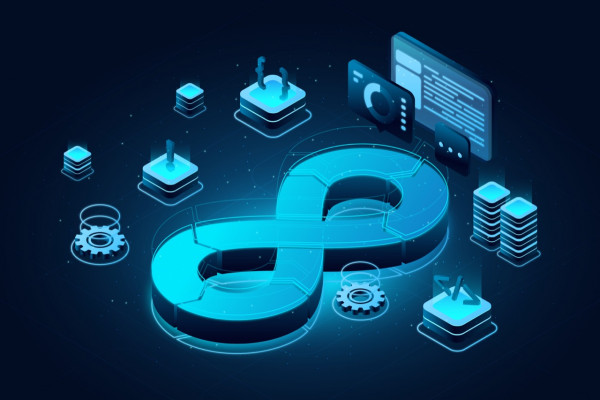Moving from on-premises systems to the cloud for computing requirements is the first step in preparing your organization for future success. Access additional apps, improve data access, enhance team collaboration, and simplify content management through the cloud. Cloud computing security ensures that authorized users can access data and applications. You always have a reliable means of accessing your cloud apps and information, so potential security concerns can be quickly addressed.
Some individuals may be hesitant to move to the cloud owing to security concerns. Still, a reputable cloud service provider (CSP) may set your mind at ease by providing highly secure hybrid cloud services.
How does cloud security work?
Protect the Server: Traditional networks lacked safeguards to fully protect servers. Your server should be protected from threats. Instead of sending traffic directly to your servers, Cloud Web Security sends traffic to the cloud. The cloud filters traffic and only allows access to authorized users. The cloud prevents unacceptable data from reaching our servers.
Examines and organizes data: Applications in older systems filter data before it hits the server. The apps are expensive and difficult to keep up with. They monitor traffic after it has arrived at their network. When the machines get overloaded, they may shut down, blocking both good and harmful traffic and failing to perform their intended functions.
Cloud web security services divert traffic to the security cloud-first, which is screened before entering the application system.
Data Administration and Secure Encryption: Encryption methods employ complicated algorithms to conceal and safeguard data. Cloud-based security controls data identification and restricts access from unidentified programs that may decrypt encrypted information.
Why do we need Cloud Security?
Increasing Security Breach Instances: The number of security breaches is expanding at an alarming rate. Some security breaches force businesses to temporarily shut down their websites and mobile applications, while others cause them to lose a major portion of their yearly revenue. Without a solid cloud security plan, no organization can battle increasing security flaws and cybersecurity threats.
Security Options Vary Between Cloud Service Providers: Every cloud service provider commits to keeping organizations’ apps and data safe. Major hybrid cloud service providers allocate staff to cloud computing security implementation and monitoring. However, many cloud service providers use third-party security organizations to manage and monitor cloud security. As a result, cloud security installations and monitoring quality and efficiency vary from one cloud service provider to the next. To implement cyber defense, organizations must assess the security instruments and methods used by the service provider.
Several factors influence data storage location: Cloud service companies often keep client data in various geographic locations. As a result, businesses frequently struggle to understand where their data is housed and how it is isolated from other data. As a result, organizations must select the most trusted security choice and continuously check the cloud computing security plan.
Benefits of Cloud Security
Round-the-clock threat prevention: Skilled cloud architects implement security across all your applications and access ports. A cloud security solution must contain developed processes, transparency, tracking, 24/7/365 monitoring, and industry-leading infrastructure to deliver an adaptive threat management system.
Constant monitoring and traffic distribution can avoid threats such as DDoS (denial of service) assaults.
Data Security: A solid and hybrid cloud security solution safeguards data throughout its lifespan, from creation to disposal. Encryption, multi-factor authentication, and validated backups should be used to secure critical data. Internal and external disciplinary policies must be created to limit data access according to the concept of least privilege.
Scalability: A scalable cloud computing system can modify capacities, security coverage, and pricing in response to fluctuations in demand. For example, server bandwidth is increased during high-traffic periods to prevent server breakdowns. However, as demand drops, charges are reduced.
Regulatory Compliance: Financial firms and eCommerce have more industry and government rules than others. A strong Content Delivery Network (CDN) can provide an improved infrastructure that allows regulatory compliance while protecting consumers’ financial and personal data.
Pay as you Go Model: With the cloud security model, you pay for what you use rather than making any upfront commitment.
Challenges in Cloud Security
Cloud Service Providers (CSPs) operate data centers in geographically scattered regions. Therefore, consumers are ignorant of the specific location of their sensitive data in cloud computing. This creates many security difficulties and dangers. Because of the quick propagation of threats in virtualized environments, standard security solutions such as firewalls, host-based antivirus software, and intrusion detection systems do not provide appropriate protection.
Data Breach: Few companies have the resources and tactics to address data breaches meaningfully. As a result, it is a crucial problem that must be addressed proactively.
Failure to handle data appropriately (through purposeful encryption) exposes your company to significant compliance concerns, not to mention data breach penalties and substantial violations of consumer confidence. Regardless of what your Service-Level Agreement (SLA) states, it is your responsibility to secure your customers’ and employees’ data.
Adherence to Regulatory Laws: Small and medium-sized businesses tend to believe that cooperating with a cloud solutions provider provides them with optimum security. But that’s just the tip of the iceberg.
Compliance extends beyond international and federal laws. There are also extra industry standards to consider. Examples include FISMA, GLBA, PCI DSS, FERPA, HIPAA, and EU data protection.
The right cloud computing security solution offers the technical ability to meet regulatory requirements, but requires constant monitoring and attention to detail. Cloud providers provide hybrid cloud security based on a responsibility model, and end users provide cloud security.
Cloud Security Tools
Cloud Workload Protection Platform (CWPP): Cloud workloads comprise cloud applications’ computing, storage, and networking capabilities. Cloud Workload Protection Platforms (CWPPs) provide security tailored to the demands of applications deployed in public, private, or hybrid cloud environments. A CWPP’s goal is to secure applications by ensuring protection for the application and associated cloud capabilities.
Cloud access security brokers (CASBs): A cloud access security broker (CASB) is a security policy enforcement point on-premises or in the cloud that sits between cloud service customers and providers, combining and interjecting corporate security policies as cloud-based services are accessed. Consider the CASB as the policeman who enforces the rules established by the cloud service administrators.
Cloud security posture management (CSPM): Cloud Security Posture Management (CSPM) is an industry category for IT security products meant to identify cloud misconfiguration issues and compliance threats. One essential goal of CSPM programming is to continually check cloud infrastructure for security policy gaps.
Cloud Security Solutions
1. Identity and access management (IAM): allows administrators to specify who may conduct actions on specific resources, providing complete control and visibility over Google Cloud services. In addition, IAM gives a uniform view into security policy throughout your business, with built-in auditing to facilitate compliance processes for companies with complicated organizational structures, numerous workgroups, and multiple projects.
2. Data loss prevention (DLP): protects sensitive or vital information in a business against cyber assaults, insider threats, and unintentional disclosure. Cloud DLP solutions expose and safeguard confidential information in SaaS and IaaS applications.
3. Security information and event management (SIEM): SIEM systems enable enterprises to collect, store, and analyze security information throughout their company while alerting IT administrators/security teams to potential threats. SIEMs will allow IT teams to identify and respond to various threats across large networks in today’s complex digital environments.
4. Business continuity and disaster recovery (BC/DR): is as critical to cloud computing as it is to any other technology. An entire cloud provider or a significant infrastructure component can fail. Accepting this risk is generally a fair decision, depending on your provider’s history and internal availability capabilities. Downtime is another possibility. However, it is dependent on your RTOs. Selecting a secondary provider or service should be done with caution if that service is also situated or relies on the same provider.
Cloud Security Best Practices
Identifying the conditions and risks of cloud usage: Data is the backbone of modern enterprises, and the theft of regulated data may lead to legal penalties or even intellectual property loss. First, you must accurately identify and mark your sensitive and regulated data. After this, you must monitor and evaluate who has access to this data and how it is used. Finally, in your cloud environment, look for access controls and permissions on files and folders and other relevant parameters such as user roles, device type, etc.
Protecting your cloud environment: After identifying your sensitive data, you should apply control and protection policies to establish which data may be kept in the cloud and which requires additional safeguards. When encrypting regulated data, it is advisable to utilize your encryption keys. Although some cloud services provide encryption features, the provider will retain access to these encryption keys.
Responding to threats and problems: Identify access situations that need additional verification steps and implement multi-factor authentication to guarantee it is not an attacker impersonating a legitimate user. In addition, you may automatically change access policies when new cloud services are added to your current infrastructure.
Cloud Security Use Cases
Threat intelligence analysis: Insights into attacker origins, signs of compromise, and behavioral trends connected to cloud account use and cyberattacks on various cloud services. Machine learning algorithms in the cloud can gather and evaluate threat intelligence inputs at scale.
Modeling endpoint and network activity: Because most endpoints are not already in the cloud, cloud-specific endpoint behavior modeling is expected to become popular. However, network flow modeling is a security monitoring use case that should be explored for in-cloud AI processing.
Fraud detection: For financial services organizations and insurers, fraud prevention necessitates massive inputs and data types and several intense forms of processing. Text mining, social network analysis, database searches, and anomaly detection are all combined at scale with predictive models.
Data classification and monitoring: Cloud analysis engines may identify and tag all data uploaded and generated in cloud settings based on established regulations and then monitor for usage. Previously identified content types and trends drive the analysis.
Conclusion
Blockchain will play a critical role in restoring a high degree of certainty about ownership and accountability. For example, blockchain-based smart contracts regulate your interactions with various cloud providers. If it fails or has an issue, an SLA exception will instantly credit you, as it’s on your smart contract. The combination of the cloud and blockchain is how we will conduct cyber security correctly and return power to individuals and businesses that desire it.
Privacy will be crucial in cloud computing security. The world is imposing privacy, which should be at its core. For example, we must always utilize adequate encryption and deploy it for every piece of PII or proprietary information. This necessitates an awareness of encryption overhead, key management, and all of the numerous data locations in the cloud’s tiered paradigm so that enterprises can efficiently deploy encryption and data security.
FAQs
1. How do you prevent cloud security threats?
For most enterprises, the security dangers are easily explained: uneducated staff. However, you may reduce the risk and avoid cloud security issues by educating your staff on suitable protection measures.
The risk of irreversible data loss is increasing as the cloud matures. Make sure you have a safe backup of your data if something goes wrong.
The location of your stored data is crucial, but it is not nearly as crucial as who has access to it. To mitigate risk, implement access restrictions. Even for external identities, connect credentials to back-end directories.
2. Is the cloud secure by default?
Cloud-based approaches with a shared server give greater security than most businesses desire or can afford.
While individuals believe they have more authority over their dedicated storage, the fact is that you are in a camp alone, without assistance or backup, and vulnerable to the weather. A third-party cloud system provides the security and safety of a backup plan, specialists to handle and prevent problems, firewalls, strong surveillance, controlled access that is more difficult to access than physical servers, scheduled upgrades and updates, and auditing. All of this is included in your yearly or monthly costs, with no further investment or labor required from your organization.
3. What are the fundamental principles of cloud security design?
- Customer data transiting networks should be sufficiently safeguarded against alteration and spying. Several techniques improve network security, such as auditing and modeling your infrastructure to identify weaknesses.
- User data and the assets that store or process it should be safeguarded against physical manipulation, loss, destruction, or confiscation.
- A hostile or compromised service user should not be able to interfere with the service or data of another.
- The service provider should have a security management structure that organizes and leads the administration of the service and the information contained within it.
4. What is the latest cloud security technology?
Cybersecurity mesh: When it comes to the cloud, businesses have their assets and data outside their network, which must be safeguarded. Cybersecurity mesh is the notion of a dispersed network and infrastructure that creates a security barrier around the network’s people and devices.
Hybrid environment: A company can shift all of its data to the cloud or have some of its information in the cloud and other services housed privately. Most businesses prefer the hybrid strategy because it is more secure than putting everything in the cloud.
Cloud-native platforms: While working on cloud platforms, cloud-native apps are becoming increasingly popular. These programs are particularly developed for cloud use. Additionally, cloud-native apps take advantage of the cloud platform’s speed and efficiency.



